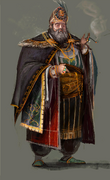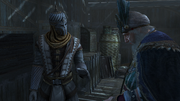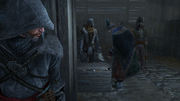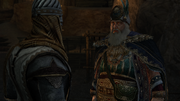No edit summary Tag: sourceedit |
No edit summary Tags: Visual edit apiedit |
||
| Line 9: | Line 9: | ||
|appear = ''[[Assassin's Creed: Revelations]]''<br>[[Assassin's Creed: Revelations (novel)|''Revelations'' novel]]<br>''[[Assassin's Creed: Recollection]]'' |
|appear = ''[[Assassin's Creed: Revelations]]''<br>[[Assassin's Creed: Revelations (novel)|''Revelations'' novel]]<br>''[[Assassin's Creed: Recollection]]'' |
||
|voice = [[Vlasta Vrána]]}} |
|voice = [[Vlasta Vrána]]}} |
||
| − | '''Manuel Palaiologos''' (1455 – 1512) was a Byzantine nobleman, born as an heir to the throne of the [[Byzantine Empire]]. In his youth, Manuel became associated with and joined the [[Templars|Templar Order]], fueling his hopes of restoring his family's lost |
+ | '''Manuel Palaiologos''' (1455 – 1512) was a Byzantine nobleman, born as an heir to the throne of the [[Byzantine Empire]]. In his youth, Manuel became associated with and joined the [[Templars|Templar Order]], fueling his hopes of restoring his family's lost empire. |
Posing as a wealthy Ottoman citizen, Manuel schemed the revival of the Empire and the reclamation of [[Constantinople]], which was at the time ruled by the [[Ottoman Empire]]. Together with [[Shahkulu]], Manuel expanded his army of Byzantine Templars, secretly hidden in [[Derinkuyu]], Cappadocia to make his childhood hopes a reality under the Templar banner. |
Posing as a wealthy Ottoman citizen, Manuel schemed the revival of the Empire and the reclamation of [[Constantinople]], which was at the time ruled by the [[Ottoman Empire]]. Together with [[Shahkulu]], Manuel expanded his army of Byzantine Templars, secretly hidden in [[Derinkuyu]], Cappadocia to make his childhood hopes a reality under the Templar banner. |
||
Revision as of 05:45, 12 August 2015
- "...I am not the only one with this vision, Assassin. The dream of our Order is universal. Ottoman, Byzantine... these are only labels. Costumes and facades. Beneath these trappings, all Templars are part of the same family."
- ―Manuel to Ezio Auditore da Firenze, 1512.[src]
Manuel Palaiologos (1455 – 1512) was a Byzantine nobleman, born as an heir to the throne of the Byzantine Empire. In his youth, Manuel became associated with and joined the Templar Order, fueling his hopes of restoring his family's lost empire.
Posing as a wealthy Ottoman citizen, Manuel schemed the revival of the Empire and the reclamation of Constantinople, which was at the time ruled by the Ottoman Empire. Together with Shahkulu, Manuel expanded his army of Byzantine Templars, secretly hidden in Derinkuyu, Cappadocia to make his childhood hopes a reality under the Templar banner.
Biography
Early life
Manuel was born circa 1455, two years after the Fall of Constantinople, as an heir to the Byzantine throne and son to one of the two Despots of Morea. He lived with his family in Glarentza, but in 1460 the Ottomans invaded, leading them to flee to Corfu. The family later fled to Rome, where Manuel's father, Thomas Palaiologos, converted to Catholicism and was recognized as the Byzantine Emperor.
During their time in Rome, Manuel and his brother Andreas fostered hopes of refounding the Byzantine Empire. Through Andreas, Manuel became acquainted with Rodrigo Borgia, Grand Master of the Templar Order, and Cem, brother to the Ottoman Sultan Bayezid II. The brothers became members of the Templar Order, and with Rodrigo's support, they schemed to conquer Constantinople and restore the Byzantine Empire. While his brother preferred a more military approach to taking back the city, Manuel tended to go for the more subtle route.[1]
Reviving the Byzantines
Manuel moved to Constantinople some time after 1485, where he traded his rights to the Byzantine throne with Sultan Bayezid II for a wealthy pension. He converted to Islam, and became the very model of an Ottoman citizen. By the 1490s, when Rodrigo Borgia became Pope Alexander VI, he lost interest in the Palaiologi's ambitions for Constantinople and the two brothers had to continue their plans without his support.[1]
In 1509, after an earthquake struck Constantinople and the Ottoman Sultan fled, Manuel brought an army of Byzantine Templars into public light and a secret war erupted between the Byzantines and Ottomans throughout the country.[1] Operating from the underground city of Derinkuyu in Cappadocia,[2] Manuel kept his involvement a secret while the Ottoman Sultan continued to be unaware of the Byzantines' presence, as he fought with his son Selim over the succession of the Ottoman throne.[1]
Prince Ahmet, son of Sultan Bayezid II and his favored heir, developed an interest in the Templars' ideology and quickly joined their ranks, working his way up through the hierarchy. Younger and more charismatic than Manuel, Ahmet silently took his position as leader of the Byzantine Templars away from him.[1]
Later life
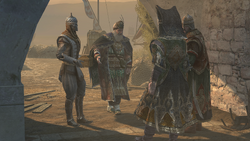
Manuel and Shahkulu meeting with Tarik Barleti
- "Twenty years in this city, living like a cipher... and finally, everything is falling into place."
- ―Manuel to Shahkulu, 1511.[src]
Manuel was eventually assigned to the Templars' Masyaf expedition to retrieve the Masyaf Keys needed to open the underground library in Masyaf, built by the legendary Mentor of the Levantine Assassins Altaïr Ibn-La'Ahad. With the help of the journal "The Secret Crusade" by Niccolò Polo, the Templars were able to retrieve a Masyaf Key from underneath Topkapı Palace in Constantinople, which was brought into Manuel's possession.[1]
In late 1511, Manuel made a deal with Tarik Barleti, captain of the Ottoman Janissaries, to buy Ottoman guns for his secret army in Cappadocia. Together with his fellow Templar, the Turkmen renegade Shahkulu, Manuel met with Tarik in Constantinople and checked on the weapons in the city's arsenal. They left the city again and set sail for Cappadocia, but were later followed there by the Italian Assassin Ezio Auditore da Firenze with help from fellow Assassin Piri Reis.[1]
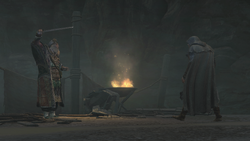
Manuel confronted by Ezio Auditore
After Ezio's arrival in Derinkuyu, the Byzantine Templars hidden in the city quickly saw their ranks diminished and eventually Shahkulu was assassinated by the lone Assassin. After Ezio caused the Templars' munitions supplies to explode, Manuel came into the public to calm and rally the citizens. As soon as he caught sight of Ezio, Manuel fled deeper into the caverns.[1]
He rapidly came to a halt at an underground river, where he was left with no choice but to confront the Assassin. Drawing his sword, Manuel engaged Ezio in a duel, but was swiftly outmatched due to his age and size and was dealt a fatal blow. With his dying breath, Manuel gave Ezio his Masyaf Key and dared him to see if he could reach Altaïr's library alive, after which he expired.[1]
Trivia
- Manuel is a name derived from Hebrew 'Immanu'el, "God is with us". Palaiologos is a combination of Greek words palaios, "old, ancient" and logos, "word, speech, discourse".
- Some heralds refer to him as "Emperor Manuel". If he had indeed assumed the title of Byzantine Emperor, this would make him Manuel III Palaiologos.
Gallery
References

